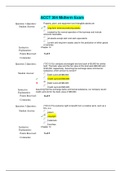College aantekeningen
Master's Project - SPSS analyses - Fully typed out basic lectures
- Vak
- Instelling
Very helpfull document of the fully typed out basic lectures for your Master's Project. Step by step explanations of how to perform different SPSS analyses needed for your thesis.
[Meer zien]







